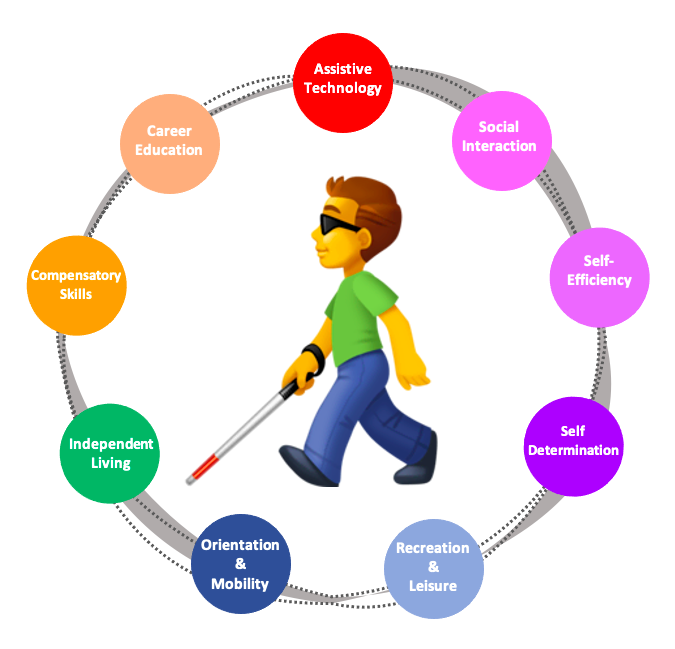Expanded Core Curriculum (ECC) is the set of nine specialized instructional areas addressed by the educational team, including the teacher of students with visual Impairments, the certified orientation and mobility specialist and other school personnel qualified to provide instruction. The ECC areas are used as a framework for assessment to identify specialized instructional needs that are required to enable the student to access the general core curriculum and additional needs that result from the visual impairment as required by IDEA. The heart of the ECC is to emphasize the specialized instructional needs for students who are blind, have low vision, are deafblind or have additional disabilities in conjunction with their visual impairment.

Expanded Core Currciulum
9 Instructional Areas
1. Assistive Technology (click to expand)
Assistive technology is an equalizer because it provides a student who has a visual impairment access to the educational instructional materials. The ability to access, store, retrieve, organize and produce written information using adaptive technology is a complex task for both student and teacher, requiring added time for research and instruction.
In addition, the availability of tools and devices is constantly changing. A careful selection of assistive tools and devices is needed in order to provide access to the core curriculum (reading, writing, mathematics, science and social studies) and specialty area classes (music, art, PE, etc.)
According to IDEA, assistive technology refers to both the devices and services identified as a need for special education services, related services or as a supplemental aid and service.
It is recommended that an individual who is knowledgeable in the area of visual impairments, universal tools, assistive tools and devices uniquely developed for use by individuals who are visually impaired, be a part of the assessment and selection process when determining assistive technology needs and services.
Resources
2. Career Education (click to expand)
Employment data for individuals who are blind or who have a visual impairment is concerning. Unemployment among blind adults of working age is around 70%. This percentage is significant and focus is required to address this need. Most children visually observe and learn about careers as they go with their families and friends into the community, but individuals who are blind do not get these experiences. When students are provided structured activities and work-related experiences to learn about careers, outcomes are improved. Students learn about the range of available careers, what people do when on the job, and begin to examine their own career interests.
It is clear that for successful employment outcomes, career education must be infused in the curriculum from early childhood, through high school and beyond. Young children can learn about all of the types of jobs represented in their own community. As the student advances in grade levels, this awareness can expand and include instruction in job tasks, practical experiences through volunteer work and paid opportunities in the local community. All of these can help the student form more personal employment interests.
Resources
3. Compensatory Skills (click to expand)
Compensatory academic skills are necessary to access the core curriculum and include communication methods such as braille, nemeth code, tactile graphics, and tactual symbols. Also included are ways to access the print environment through braille, print, digital or audio formats. In addition, this area includes ways to access digital content, complex mathematics or science, diagrams, charts and graphs through accessible learning software, large print, talking calculators and the abacus. Additionally, organization skills, concept development, study skills and sign language are included in this vast set of skills covered by the teacher of students with visual impairments. Speed, comprehension, ease of use and the stamina to access the educational curriculum is a critical component to ensure a student who is blind or has a visual impairment develops literacy in print, mathematics and computers.
Resources
- American Printing House for the Blind – APH Products
- Digital Transitions
- Accessible Instructional Materials
4. Independent Living (click to expand)
Activities of daily living (hygiene, grooming, dressing, organizing, accessing one’s personal space and belongings, food preparation and consumption) play an important role in independence. These skills are typically acquired through incidental learning opportunities based on observation and play, but for the student who is blind or visually impaired, intentional teaching is more beneficial. The resources listed below may not be exclusively designed for students who have a visual impairment, but can be used by the TSVI in teaching areas of the ECC.
Resources
5. Orientation and Mobility (click to expand)
Along with literacy, orientation and mobility (O&M) is considered an essential skill for individuals who are blind or visually impaired because it provides the foundation for independent functioning. O&M is part of the expanded core curriculum and is an IDEA related service. O&M is considered as a possible need related to the visual impairment for children ages birth to 21. O&M teaches the student how to safely and efficiently move or travel in the environment. Specialized instruction is provided in familiar and unfamiliar indoor environments, home and school, residential neighborhoods, business environments, navigating intersections and using public transportation. Instruction may include the use of the cane, monocular, GPS systems, and paper or digital maps. This related service must be provided by a certified orientation and mobility specialist (COMS).
Resources
6. Recreation and Leisure (click to expand)
We all need to have a balanced lifestyle that includes employment and work along with recreation and leisure. The benefits of balancing work and leisure are vast and include: improved health, reduced stress and less depression. Students who are blind or who are visually impaired may not visually observe many of the opportunities available for either active or passive recreation and leisure activities. Intentional awareness and instruction in this ECC area is critical to prepare for life beyond high school. Active leisure activities include movement such as dancing, running, swimming and passive leisure activities such as reading, visiting with friends, or watching a movie.
Resources
7. Self-Determination (click to expand)
Self-determination includes choice-making, decision-making, problem solving, personal advocacy, assertiveness, and goal setting. Students who have a visual impairment often experience receiving a lot of help when completing tasks. As a result they may experience fewer opportunities to problem solve or make choices. Allowing the student to make decisions, set goals and solve daily problems will increase chances for their independence beyond high school.
Resources
8. Sensory Efficiency (click to expand)
There is a perception that when an individual has a visual impairment, their other senses (hearing, touch, smell, taste) are automatically heightened. That is not necessarily true. Some individuals may improve the use of their senses due to attention and practice, while others may require support and instruction. Keep in mind that vision loss can appear confusing to others. A student may walk around the hallways never bumping into anything and yet in the classroom, can’t read the print on a page or describe a photograph accurately. In addition, when a student is asked if they can see an assignment easily, the common answer is “yes”, even though they cannot. The student is not lying, they just may not realize their vision does not provide the same accuracy as those who aren’t visually impaired. As a result – it is necessary to determine if a student needs specialized instruction in sensory skill development.
Resources
9. Social Interaction (click to expand)
Almost all social skills are learned by visually observing other people. This includes interpersonal communication skills with peers, employers, friends and colleagues. In addition, it includes the conversational skills, non-verbal communication such as gestures, facial expressions and personal space. Structured learning opportunities embedded within the school day will lead to increased confidence when navigating social interactions in all kinds of environments.
Resources
Resources for Support (click to expand)
ECC Flyer from the Texas School for the Blind Website – “What is the Expanded Core Curriculum”
Kansas Resources document – See
- Deaf-Blind Programs and Services for Kansas Students Brochure – in PDF OR
- Deaf-Blind Brochure in text format
Expanded Core Curriculum on Paths to Literacy


